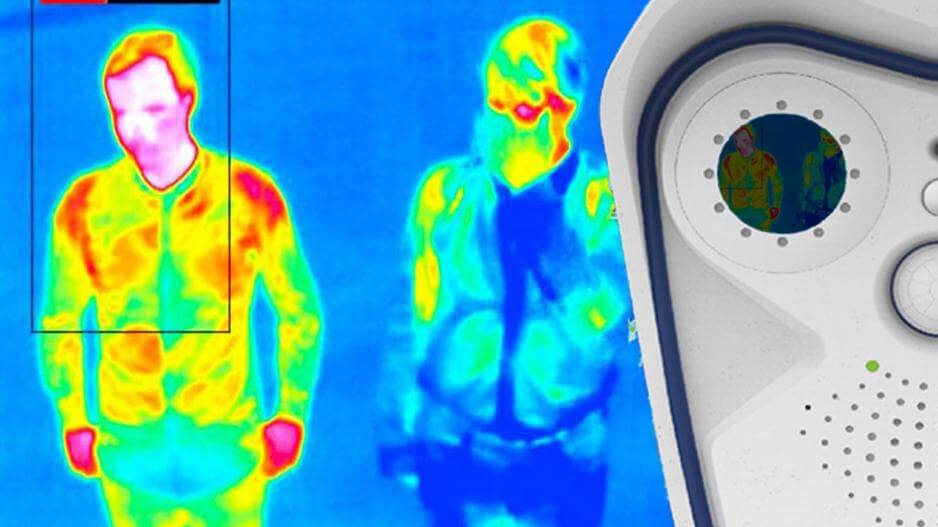Thermal imaging technology has been used in various industries for decades. However, cameras with thermal imaging capabilities are now being applied in different fields more frequently as a response to the recent events in the world.
The sudden outbreak of the Covid-19 pandemic has led industries to improve safety and health protection measures. Thermal imaging has emerged as a preferred non-invasive, cost-effective measure to ensure workplace safety and prevent the further spreading of the virus. Thermal imaging cameras are now an integral component of a holistic commercial security system solution.
What Can Thermal Imaging Cameras Do
Industrial companies, medical and health organizations, and various public institutions historically used thermal imaging cameras to prevent overheating of machinery, evaluate energy losses, and visualize entities in low-visibility environments. These cameras can also detect human temperature and record even the slightest temperature changes of 0.1 degrees Celsius.
Such delicate technology can be integrated in existing video surveillance equipment, making businesses able to detect risks of contagion or illness in symptomatic employees, to protect the health of the office ecosystem.
During the current global pandemic, this level of surveillance has become mandatory in public areas and medical institutions. Medical and security staff use thermal imaging cameras to scan people before allowing them to enter facilities. As higher temperature is a sign of viral infection and possible contagion, the staff can recognize potentially infected patients and quickly remove them from the healthy population without hands-on testing.
New thermal imaging cameras and intelligent video surveillance systems are even able to send alarms or messages when it recognizes a drastic temperature change worth of attention.
How to Measure Temperature with Thermal Imaging Cameras
Thermal imaging cameras are designed to provide accurate thermal recordings based on heat signatures. They translate thermal radiation, which is normally not visible to the naked eye, into visual images with different colors indicating heat levels. For example, dark red stands for abnormally high temperatures, whereas blue shades indicate cooler temperatures. The thermal imaging results are fairly simple to read and anyone trained to use these devices can identify normal from abnormal temperatures.
>>Read the free MOBOTIX Thermal Solutions Compact Guide
No-contact temperature measurement
While thermal imaging is often integrated into security systems and distant cameras, it can also be integrated into hand tools used to measure temperature. This technology is a perfect tool to measure temperature safely, as there is no unnecessary contact with potentially infected individuals. In order to get an accurate reading using thermal imaging technology at hand, one should point the device toward the target and hold it still for a couple of seconds as the camera creates the visual results.
The resolution of the camera is an important factor to keep in mind, as it dictates the quality of the final measurements. A term to be familiar with before using thermal imaging cameras is NETD, which is usually measured in mili-Kelvin (mK). It stands for Noise Equivalent Temperature Difference and it will indicate the ability of the thermal imaging detector to pinpoint the smallest differences in thermal radiation.
Other critical factors include:
- Field of view: The field of view refers to the angle at which the camera records. In order to get the most accurate results, the target must completely fit in the field of view of the camera.
- Spectral response: The spectral response, on the other hand, refers to the sensitivity of the photosensors to different levels of wave lights or radiation. This technical feature should be kept in mind when choosing surveillance system equipment.
High quality thermal imaging cameras can measure a wide temperature range from -40 degrees to up to 550 degrees Celsius, which translates to up to 1022 F. What is more important for the current health concerns is the thermal imaging tech’s sensitivity to detect the slightest temperature changes, which can help users spot individuals with higher fever that stand out from the healthy population. The integrated thermal image sensor in each camera displays the exact location of the concerning hot spots, which can help detect infected individuals.
The Increase in Thermal Imaging Technology Applications
While thermal imaging technology has had an industrial purpose for decades, we are now able to see its real potential in security surveillance. This technology is already helping detecting individuals with potentially increased fever and thus allow the security staff to stop them from entering workplaces like commercial buildings, government facilities, or shared office spaces.




